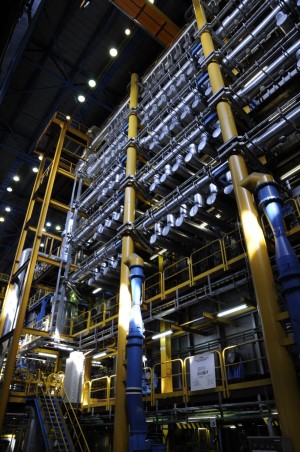The use of hydrogen in the steel making process is an important topic affecting manufacturers around the globe. Stainless Steel World spoke to Ilya Pavlov, Head of Decarbonization Projects at the Russian steel producer Severstal, about its strategy to move ahead with decarbonization.
While many companies in the steel sector only consume polarized coal, Severstal consumes a substantial amount of natural gas in its blast furnaces, a cleaner way to produce steel. “We have several projects ongoing, mostly at the R&D stage,” begins Mr Pavlov. “Natural gas already contains hydrogen molecules, but to decarbonize the blast furnace further, we need to find a way of feeding it with some amount of pure hydrogen in addition to natural gas.”
The biggest challenge the company faces is the price of hydrogen and its availability in industrial quantities. In order to its feed blast furnaces with pure hydrogen, the company would need tens of tonnes per year.
“The more obvious way to use hydrogen is to produce steel using DRI and electric-arc furnaces. First, natural gas is reformed into so-called syngas ‒ hydrogen and CO. It is then need-fed into the Direct Reduced Iron (DRI) furnace, thereby reducing iron oxide to iron and combining it with scrap in the electric-arc furnace to make steel. The carbon footprint of this method is much smaller compared to the blast furnace and converter method.”
Further reducing CO2
“Companies can then take this further by capturing CO2 from the steam methane reformer and storing it,” continues Mr Pavlov. “One of the strategic initiatives that our memorandums with our partners are focused on is discovering methods to store CO2. We would look for the right geological location, not too far from our production facilities, and build the needed infrastructure. We will be working on this initiative jointly with our strategic partners, including Gazprom Neft and Novatek.”
“If we follow the DRI path, another way to reduce carbon footprint is to add hydrogen to the reducing gas (syngas) from an external source. The bulk of the reducing gas is produced with the steam methane reformer, with hydrogen (from a low-carbon source) being added. The DRI furnace is then fed with reducing gas and hydrogen.”
“The challenge is finding the right hydrogen source with the optimal carbon footprint and price. With the steam methane reformer, the hydrogen price usually varies between $1.5-2; if we add CCS (carbon capture and storage technology), this brings it to around $2.5. To add hydrogen from an external source, it would have to be under $1.5 ideally.”
Disruptive hydrogen technologies
“In Europe, we see a gradual transition from blast furnaces to DRI and electric-arc furnaces, with more hydrogen being added to DRI plants as it becomes available,” explains Mr Pavlov.
“While most steel plants should have hydrogen available from water electrolysis, vast amounts of renewable energy would be required (several hundred megawatts for the average size DRI plant). Here in Russia, we don’t have access to much renewable electricity, although we do have solar, natural gas, and a lot of forestry land where carbon could be buried. Our corporate venture fund is looking for investment targets for disruptive hydrogen technologies such as steam methane pyrolysis, electrical reforming and hydrogen transportation technologies, which can be used in the medium term to produce and deliver relatively inexpensive hydrogen. We believe that this represents a way forward for Russia, as energy sources are not as expensive, giving us the opportunity to produce hydrogen with a low carbon footprint.”
About Severstal
Severstal is a vertically integrated steel and steel-related mining company with major assets in Russia as well as investments in other regions. The company comprises two major operational divisions: Severstal Resources and Severstal Russian Steel.
Russian State participation in hydrogen
“Russia has approved a roadmap for hydrogen, and there are several ongoing discussions on the matter. State participation would be needed to create this new industry and make it economically viable, including certain tax manoeuvres and infrastructure.”
Economics of hydrogen
 “The main difference between producing blue hydrogen from methane steam reforming and green hydrogen is the price, which is three times higher for green hydrogen. For steam methane reformer and carbon caption storage, that’s around USD 2.5 against USD 5 – 8 for green hydrogen, depending on the price of electricity. If we can keep the price of hydrogen at USD 1.5, we would not see a significant impact on the steel price.”
“The main difference between producing blue hydrogen from methane steam reforming and green hydrogen is the price, which is three times higher for green hydrogen. For steam methane reformer and carbon caption storage, that’s around USD 2.5 against USD 5 – 8 for green hydrogen, depending on the price of electricity. If we can keep the price of hydrogen at USD 1.5, we would not see a significant impact on the steel price.”
There are many components to the economics of hydrogen production, explains Mr Pavlov. “If we add hydrogen into the blast furnace, it depends on the amount added, the type of furnace used and the CO2 tax level. The DRI process is more efficient in terms of both pricing and CO2 reduction.”
“Today, hydrogen is generally produced and used in the same location, as transportation can be very expensive. Our mining site near Belgorod theoretically offers a place to store CO2. However, the challenge is not just about storing CO2, but also about the availability of electricity.”
“We believe that the conversation should not revolve about what colour hydrogen is used but rather look at the overall carbon footprint and be technology-agnostic. We are part of a net-zero steel group. Whilst our midterm goal may not be an absolute zero (Severstal has committed to reducing emissions by 10% by 2030), we remain focused on achieving ambitious yet feasible targets.”
Opening image: severstal furnace. Photo courtesy of Severstal.

